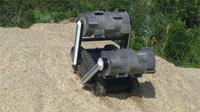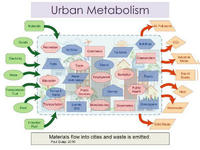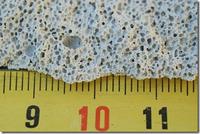-
U.S. infrastructure grade raised from D to a D+, but problems loom
The American Society of Civil Engineers (ASCE), in its just-released 2013 Report Card for America’s Infrastructure, gave the U.S. infrastructure an overall grade of D+, showing slight progress from the D in the last Report Card issued in 2009. The Report Card concludes that to raise the grades and get U.S. infrastructure to an acceptable level, a total investment of $3.6 trillion is needed by 2020. Currently, only about $2 trillion in infrastructure spending is projected, leaving a shortfall of approximately $1.6 trillion.
-
-
Building stronger, greener concrete with biofuel byproducts
The world uses nearly seven billion cubic meters of concrete a year, making concrete the most-used industrial material after water. Even though making concrete is less energy intensive than making steel or other building materials, we use so much of it that concrete production accounts for between 3 to 8 percent of global carbon dioxide emissions.
-
-
New internally cured concrete increases bridge life span
Concrete is normally made by mixing portland cement with water, sand, and stone. In the curing or hardening process, water helps the concrete mixture gain strength by reacting with the cement. Traditionally, curing is promoted by adding water on top of the bridge deck surface. The new technology for internal curing provides additional water pockets inside the concrete, enhancing the reaction between the cement and water, which adds to strength and durability. This new technology is enabling Indiana to improve bridges in the state with a new “internally cured” high-performance concrete.
-
-
New bridge construction technologies to shore up U.S. infrastructure
Experts agree that there is an urgent need to construct and repair bridges across the United States. Around 70,000 bridges in the country are considered “structurally deficient” by government standards. New technology could help the United States manage its growing, and aging, infrastructure without breaking the bank or levying high taxes on citizens.
-
-
NASA engineers building sturdy blue-collar mining robot

After decades of designing and operating robots full of scientific gear to study other worlds, NASA is working on a prototype that leaves the delicate instruments at home in exchange for a sturdy pair of diggers and the reliability and strength to work all day, every day for years.
-
-
Improving cities by using the notion of “urban metabolism”

As is the case with organisms, cities need energy, water, and nutrients, and they need to dispose of wastes and byproducts in ways which are viable and sustainable over the long run. This concept of “urban metabolism” is a model for looking systematically at the resources that flow into cities and the wastes and emissions that flow out from them in order better to understand the environmental impacts of cities and to highlight opportunities for efficiencies, improvements, and transformation.
-
-
The humble jute serves as a sustainable reinforcement for concrete
Fashionable people may turn up their noses at jute, the cheap fiber used to make burlap, gunny sacks, twine, and other common products, but new research is enhancing jute’s appeal as an inexpensive, sustainable reinforcement for mortar and concrete.
-
-
2002 Alaska earthquake helped set standards for buildings, bridges
The Denali 7.9 earthquake that hit Alaska in 2002 was the largest to hit the United States in more than 150 years, and the strongest ever recorded in Alaska; no one was killed and only a few people were injured; the only severe damage the earthquake caused was to a few highways, but the damage was not significant enough to close them; the earthquake set new national standards for building bridges as well as giving seismologists a better understanding of how earthquakes affect frozen ground
-
-
Cooler pavement materials could increase energy consumption in surrounding buildings
A push to replace old, heat-trapping paving materials with new, cooler materials could actually lead to higher electricity bills for surrounding buildings; the new paving materials are designed to lower the overall temperature of the areas where they are used
-
-
Building material of millennium: Autoclave Aerated Concrete

Although widespread rebuilding in the hard-hit New York metro region from Hurricane Sandy has not yet begun, New Jersey Institute of Technology (NJIT) scientists say when the hammers start swinging, it is time to look at autoclaved aerated concrete; the material, best known as AAC, has been heralded as the building material of the new millennium
-
-
States, localities to assume more responsibilities for rebuilding U.S. aging infrastructure
Infrastructure in the United States is in bad shape; Maryland needs more than $100 million a year for its bridges; Virginia needs $125 million per year for roads that need repaving; Washington’s failure to create a long-term funding plan to repair the nation’s infrastructure is forcing state and local governments to fill the void in federal funding
-
-
Improving high-speed rail ties against freezing, thawing conditions
Research project is helping high-speed rail systems handle the stress of freezing and thawing weather conditions; the 3-year study looks at the freeze-thaw durability of concrete railroad ties; the research is essential to developing safe and durable high-speed rail systems
-
-
Hurricanes will test Florida buildings, built under new, post-Wilma building codes
In 2005 Hurricane Wilma was responsible for five deaths and millions of dollars worth of damage in Florida; building codes in the state were updated, and experts predict that these new buildings, most of which were designed with wind-tunnel testing, should perform well in all but the most severe conditions
-
-
Assessing bridge resilience
Across the United States, more than 600,000 bridges link travelers to millions of roadway miles, forming a critical part of the nation’s infrastructure; because bridges are typically more vulnerable than roadways to damage caused by natural and man-made hazards, they are also of interest to DHS, which funds cutting-edge research in various aspects of structural integrity testing and blast-resistant structural design
-
-
Analyzing the sound of rain falling on a bridge reveals bridge’s health, stability

Engineers have found that by listening to how a highway bridge sings in the rain, they can determine serious flaws in the structure; employing a method called impact-echo testing, engineers can diagnose the health of a bridge’s deck based on the acoustic footprint produced by a little bit of water
-
- All
- Regional
- Water
- Biometrics
- Borders/Immig
- Business
- Cybersecurity
- Detection
- Disasters
- Government
- Infrastructure
- International
- Public health
- Public Safety
- Communication interoperabillity
- Emergency services
- Emergency medical services
- Fire
- First response
- IEDs
- Law Enforcement
- Law Enforcement Technology
- Military technology
- Nonlethal weapons
- Nuclear weapons
- Personal protection equipment
- Police
- Notification /alert systems
- Situational awareness
- Weapons systems
- Sci-Tech
- Sector Reports
- Surveillance
- Transportation
Advertising & Marketing: advertise@newswirepubs.com
Editorial: editor@newswirepubs.com
General: info@newswirepubs.com
2010-2011 © News Wire Publications, LLC News Wire Publications, LLC
220 Old Country Road | Suite 200 | Mineola | New York | 11501
Permissions and Policies
Editorial: editor@newswirepubs.com
General: info@newswirepubs.com
2010-2011 © News Wire Publications, LLC News Wire Publications, LLC
220 Old Country Road | Suite 200 | Mineola | New York | 11501
Permissions and Policies
